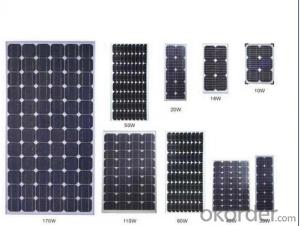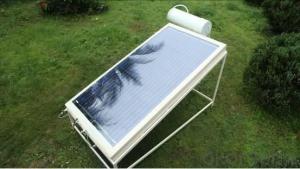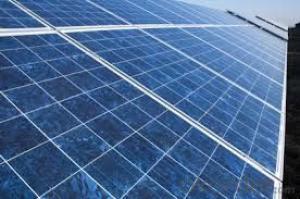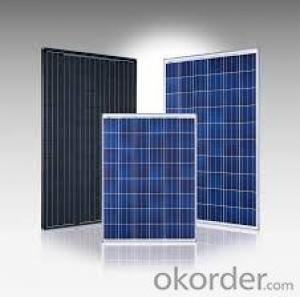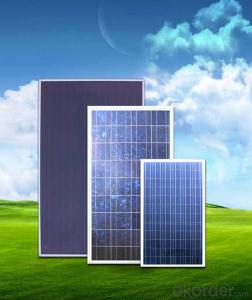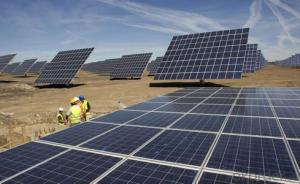Tio2 Dye Sensitized Solar Cells Newest Polycrystalline Solar Panel with Factory Price CNBM
- Loading Port:
- Qingdao
- Payment Terms:
- TT OR LC
- Min Order Qty:
- 10 set
- Supply Capability:
- 300000 set/month
OKorder Service Pledge
OKorder Financial Service
You Might Also Like
Polycrystalline Solar Modules
CNBM offers a range of small, medium and large polycrystalline solar modules, designed for a range of requirements.
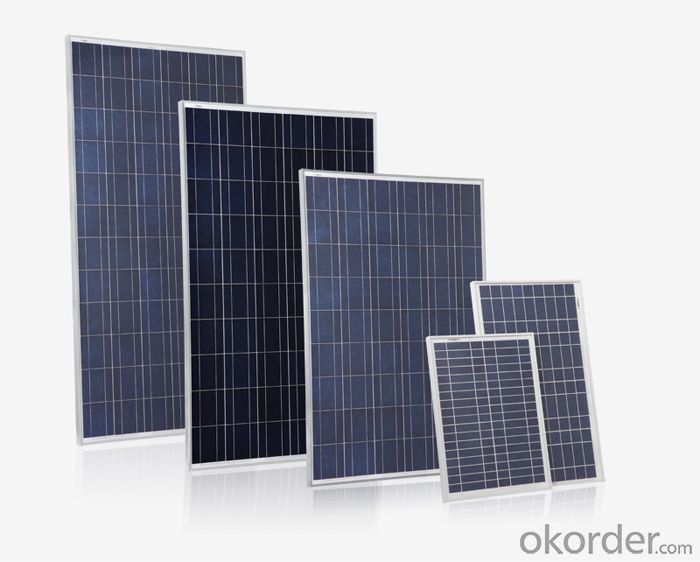
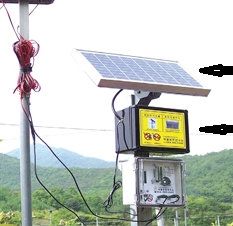
Specifications:
Tolerance | +/-3% |
Cell | Polycrystalline silicon solar cells (156 x 156mm) |
N0. of Cells | 60 (0 x 6) |
Dimension of Modules (mm) | 1650 x 990 x 40 |
Weight (kg) | 25.5 |
Limits:
Operating Temperature | -40~+85? |
Storage Temperature | -40~+85? |
Maximum System Voltage | 1000 VDC max. |
Hail Impact | Diameter of 28mm with impact speed |
Temperature and Coefficients:
NOCT | 48C+/-2? |
Voltage temperature coefficient (%/K) | -0.35 |
Current temperature coefficient (%/K) | 0.05 |
Power temperature coefficient (%/K) | -0.45 |
Characteristics:
Model: | SGM-200P | SGM-210P | SGM-220P |
Max-power voltage Vmp (V) | 29.2 | 29.4 | 29.41 |
Max-power current Imp (A) | 6.85 | 7.14 | 7.48 |
Open-circuit voltage Voc (V) | 36.5 | 36.69 | 36.9 |
Short-Circuit Current Isc (A) | 7.28 | 7.6 | 7.93 |
Max-power Pm(W) | 200 | 210 | 220 |
Model: | SGM-230P |
Max-power voltage Vmp (V) | 29.8 |
Max-power current Imp (A) | 7.72 |
Open-circuit voltage Voc (V) | 37.31 |
Short-Circuit Current Isc (A) | 8.19 |
Max-power Pm(W) | 230 |
STC: Irradiance 1000W/m2, module temperature 25?, AM-=1.5
Poly Crystalline Solar Panels Specifications Range
Maximum Power (Pm) | Dimension | Weight | Operating Voltage (Vmp) | Operating Current (Imp) | Open Circuit Voltage (Voc) | Short Circuit Current (Isc) |
0.45W | 140x80x10mm | 0.08kg | 3.3V | 150mA | 4.6V | 160mA |
1.0W | 162x140x10mm | 0.16kg | 7.5V | 150mA | 10.3V | 160mA |
4.5W | 269x251x23mm | 0.8kg | 16.5V | 0.27A | 20.5V | 0.3A |
10W | 420.1×268.9×22.6mm | 1.92kg | 17.5V | 0.58A | 20.5V | 0.6A |
20W | 425x502x50mm | 3.0kg | 16.8V | 1.19A | 21.0V | 1.29A |
30W | 593x502x22.6mm | 3.9kg | 16.8V | 1.78A | 21.0V | 1.94A |
40W | 655x537x50mm | 5.75kg | 17.3V | 2.31A | 22.1V | 2.54A |
50W | 839x537x50mm | 6.0kg | 17.5V | 2.9A | 21.8V | 3.17A |
65W | 1111x502x50mm | 7.2kg | 17.6V | 3.69A | 22.1V | 3.99A |
80W | 1204x537x50mm | 7.7kg | 17.6V | 4.55A | 22.1V | 4.8A |
- Q: How many years should I spend in the solar cell industry to be a good solar cells sales person?
- A good solar cells should be equiped with both solar cells knowledge and good sales skills, and with very good people skills. Only in this way, you will be a good one.
- Q: Can solar cells be used to power air conditioning systems?
- Yes, solar cells can be used to power air conditioning systems. Solar panels can generate electricity from sunlight, which can then be used to power air conditioning units. However, the size and efficiency of the solar panel system would need to be carefully considered to ensure it can generate enough electricity to meet the demands of the air conditioning system.
- Q: What is the lifespan of a solar cell?
- The lifespan of a solar cell can vary depending on various factors, but on average, solar cells have a lifespan of around 25 to 30 years. However, with proper maintenance and care, solar cells can even last longer, sometimes up to 40 years or more.
- Q: My son is very interested in solar cells recently, and keeps asking me about the structure of a solar cell. Can anybody help me answer that question?
- As a newly-developed power generation technology, solar cells are considered to be an evironmental-protecting green energy
- Q: What is the best sales solution for solar power cells?
- Because solar power cells are usually purchased by companies, big corporations and governments, the best way to sell solar power cells is to do promotion targeting certain industries rather than just putting commercials on TV.
- Q: How to manufacture solar cells?
- An experiment can show the whole process of manufacturing the solar cells.
- Q: Can solar cells be used in underwater vehicles or submarines?
- Yes, solar cells can be used in underwater vehicles or submarines. However, due to the limited availability of sunlight underwater, the efficiency of solar cells in generating power is significantly reduced. Therefore, solar cells are often used as a supplementary power source in combination with other power systems such as batteries or fuel cells in underwater vehicles or submarines.
- Q: Can solar cells be used in telecommunications systems?
- Yes, solar cells can be used in telecommunications systems. Solar cells can convert sunlight into electrical energy, which can then be used to power various components of telecommunications systems such as base stations, repeaters, and remote communication stations. This allows for more sustainable and independent operation of these systems, especially in remote areas where access to traditional power sources may be limited.
- Q: Are solar cells affected by shade?
- Yes, solar cells are significantly affected by shade. Even a small amount of shade can cause a significant decrease in the power output of solar cells.
- Q: Can solar cells be used in agricultural applications?
- Yes, solar cells can be used in agricultural applications. Solar panels can provide a renewable source of energy to power various agricultural processes such as irrigation systems, lighting, and ventilation in greenhouses, as well as powering electric fences and monitoring equipment in farms. Solar energy can help reduce reliance on fossil fuels and provide a sustainable and environmentally friendly solution for powering agricultural operations.
Send your message to us
Tio2 Dye Sensitized Solar Cells Newest Polycrystalline Solar Panel with Factory Price CNBM
- Loading Port:
- Qingdao
- Payment Terms:
- TT OR LC
- Min Order Qty:
- 10 set
- Supply Capability:
- 300000 set/month
OKorder Service Pledge
OKorder Financial Service
Similar products
Hot products
Hot Searches
Related keywords











